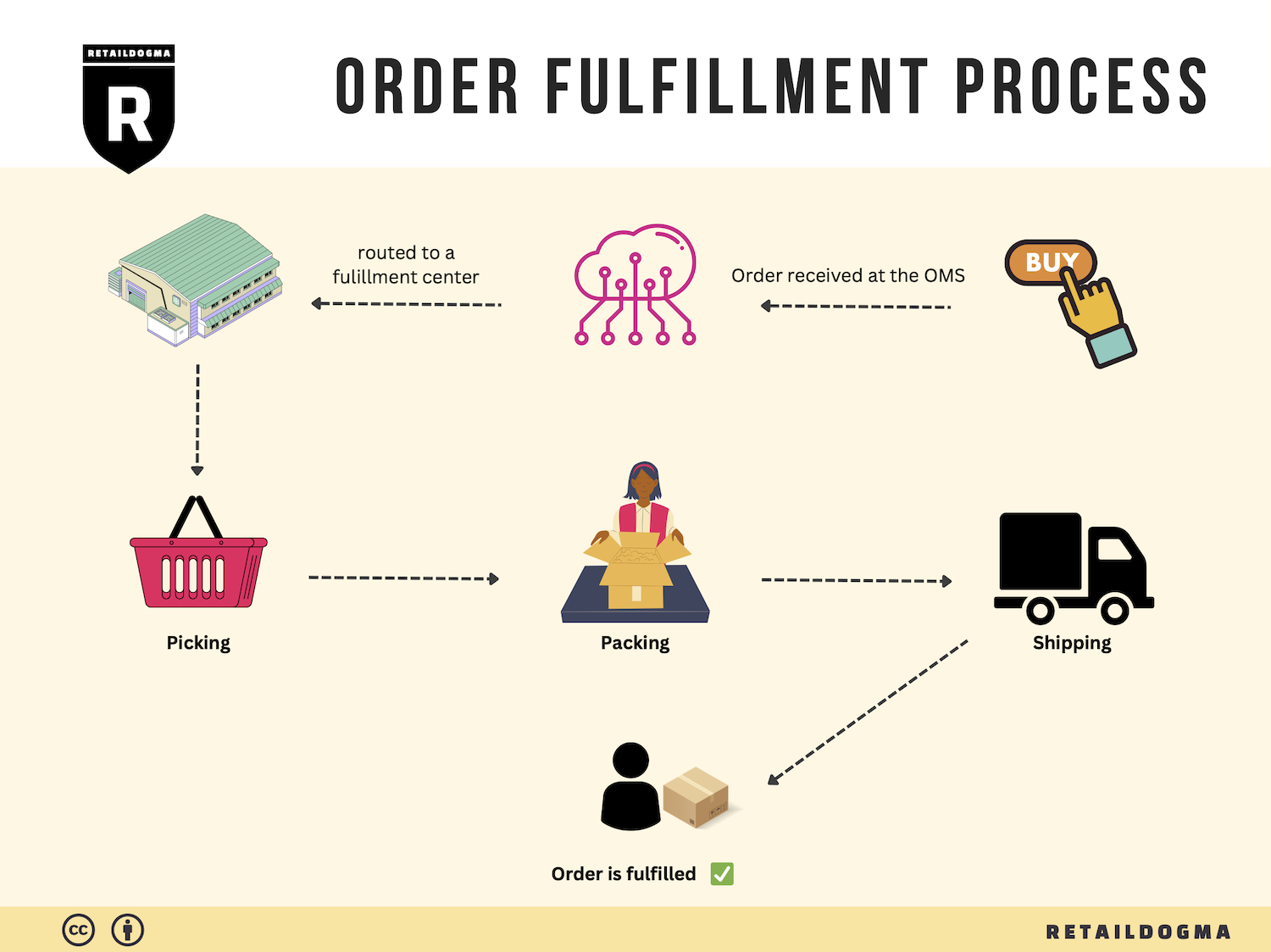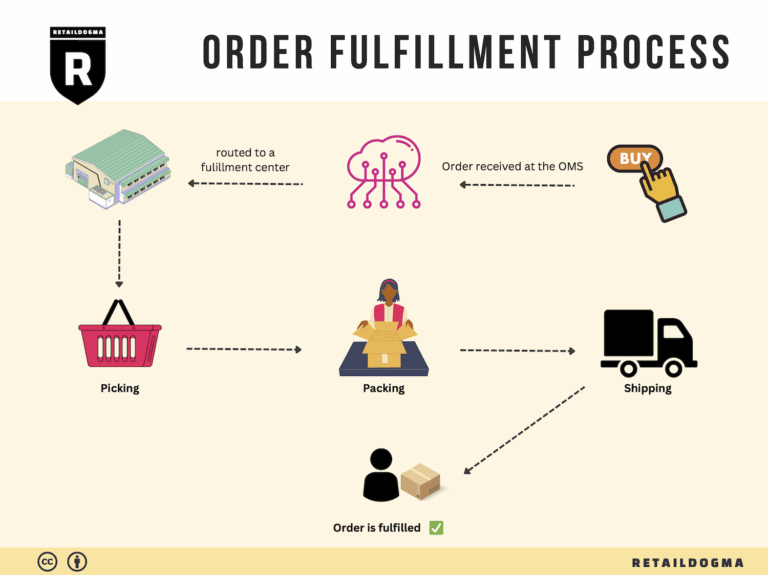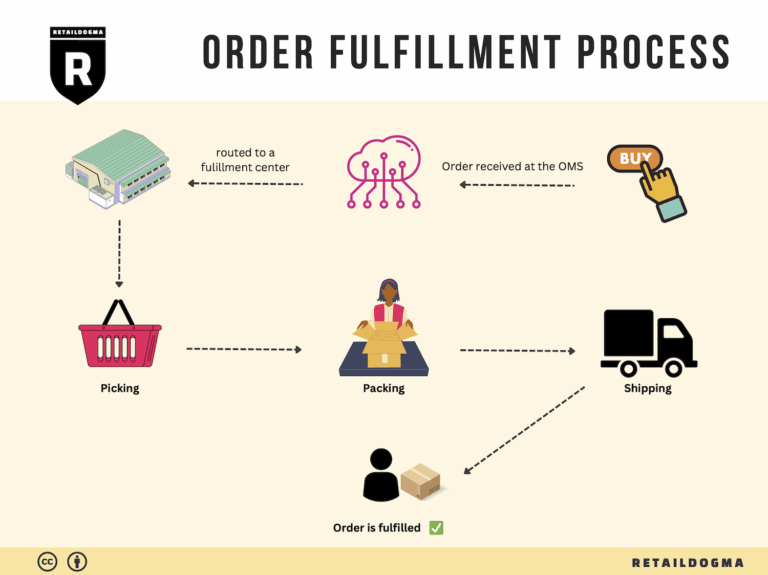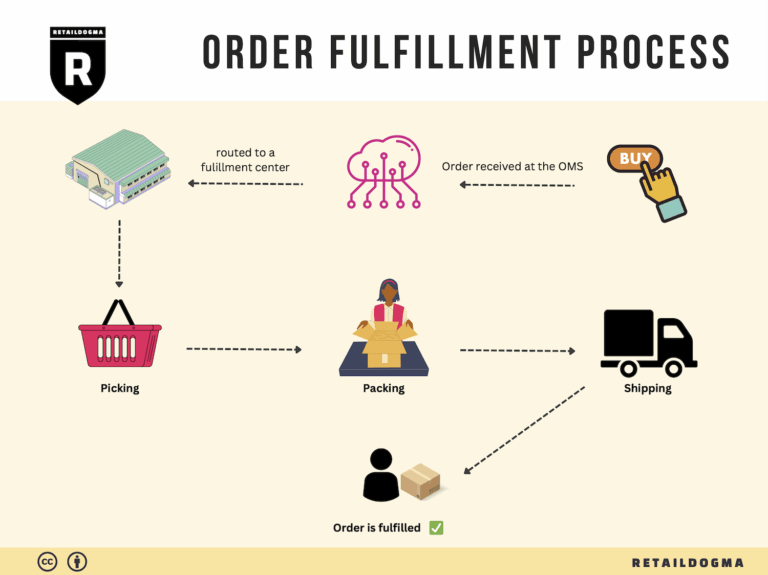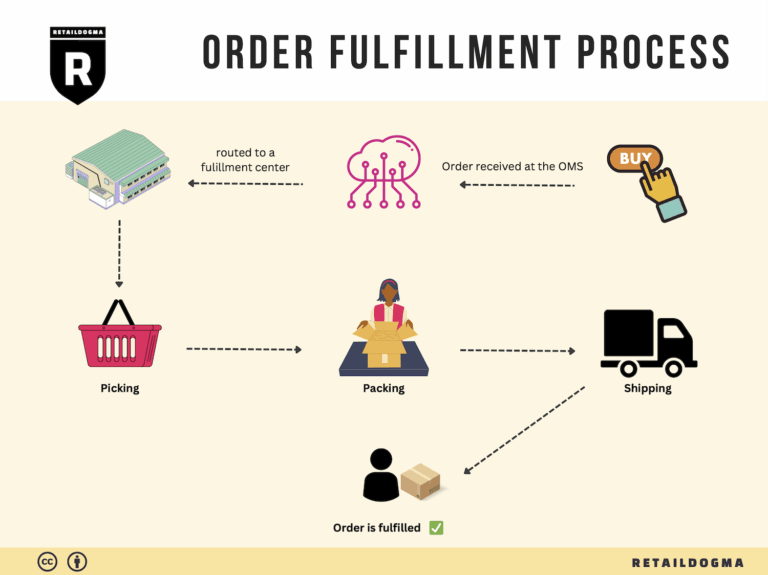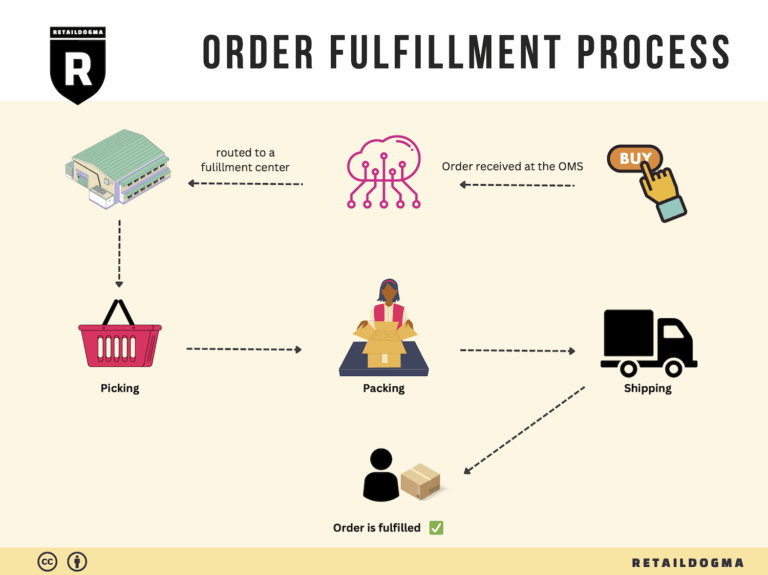What Is A Fulfillment Center? A Complete Guide (2025)
What is E-commerce Fulfillment? An Introduction for Growing Businesses
Understanding E-commerce Fulfillment
As an e-commerce business owner, one of the most daunting challenges you face is managing the packing and shipping of orders. The process can quickly become overwhelming, especially as your sales grow. You may find yourself buried in boxes, struggling to keep up with order demands, and worrying about delivery times. It’s crucial to understand that fulfillment is not just a back-end operation; it’s a vital component of your customer experience. Fulfillment, simply put, is the process of getting a product from your inventory to your customer’s doorstep, encompassing everything from order processing to shipping logistics.
In this guide, we will delve into the various models of e-commerce fulfillment, including Third-Party Logistics (3PL) and Fulfillment by Amazon (FBA). Each of these models offers unique advantages and can significantly impact your operational efficiency and customer satisfaction. We will explore the core services involved in fulfillment, such as inventory management, order processing, packaging, and shipping, which are essential for delivering a seamless experience to your customers.
Choosing the right fulfillment partner is critical for scaling your e-commerce business. We will provide insights on what to consider when selecting a logistics partner, including their capabilities, technology, service levels, and geographical reach. Additionally, we will discuss pricing structures, so you can better understand the costs involved and how they can affect your margins.
The goal of this guide is to empower you with the knowledge needed to make informed decisions about your logistics strategy. By understanding the intricacies of e-commerce fulfillment, you can optimize your operations, enhance customer satisfaction, and ultimately drive growth for your business. Whether you are just starting or looking to scale, this guide will serve as a comprehensive resource to navigate the complexities of fulfillment in the ever-evolving e-commerce landscape.
What You’ll Learn In This Guide
- What is E-commerce Fulfillment? An Introduction for Growing Businesses
- The Order Fulfillment Process: From ‘Buy’ Button to Customer’s Door
- Comparing Fulfillment Models: In-House vs. 3PL vs. Dropshipping
- A Deep Dive into Amazon FBA: Pros, Cons, and Who It’s For
- Core Services Offered by Fulfillment Centers
- How to Choose a Fulfillment Partner: A 6-Point Checklist
- Understanding Fulfillment Pricing: A Breakdown of Common Fees
- Frequently Asked Questions (FAQs) about Fulfillment
- Conclusion: Is Outsourcing Fulfillment the Right Move for Your Business?
- Important Disclaimer
The Order Fulfillment Process: From ‘Buy’ Button to Customer’s Door
1. Receiving Inventory
The order fulfillment process begins with receiving inventory, a critical step that sets the stage for efficient operations. When products arrive at your fulfillment center, they must be checked against purchase orders to confirm that the correct items and quantities have been delivered. This verification process often involves scanning barcodes or using RFID technology to ensure accuracy.
Why is this step important? Proper inventory receiving helps to prevent discrepancies that can lead to stockouts or overstock situations. By accurately logging received items into your inventory management system, you maintain a clear understanding of your stock levels, which is vital for meeting customer demand.
Key Term: SKU (Stock Keeping Unit) – A unique identifier for each distinct product and service that can be purchased. Using SKUs helps streamline inventory tracking and management.
2. Warehouse Storage
Once inventory is received and verified, the next step is warehouse storage. This involves organizing products in a way that maximizes efficiency and accessibility. Items should be stored based on their sales velocity, size, and type; for example, fast-moving items may be placed closer to the packing area to facilitate quicker order fulfillment.
Effective warehouse storage is essential for reducing retrieval times during the picking process. A well-organized warehouse not only speeds up operations but also minimizes the risk of errors and damages to products.
Key Term: ABC Analysis – A method for categorizing inventory based on importance, where ‘A’ items are the most valuable and frequently sold, while ‘C’ items are the least. This helps prioritize space allocation and management efforts.
3. Order Picking
The order picking stage is where the fulfillment process truly begins to take shape. When a customer places an order, a pick list is generated that details the items and their locations within the warehouse. Warehouse staff then use this list to locate and gather the necessary products.

This step is crucial because the speed and accuracy of picking directly affect order fulfillment times and customer satisfaction. Implementing technologies such as pick-to-light systems or mobile barcode scanners can enhance picking efficiency and reduce human error.
Key Term: Pick List – A document or digital display that outlines the items to be collected for an order, including their locations in the warehouse. It serves as a guide for fulfillment staff during the picking process.
4. Order Packing
After the items are picked, they move to the packing stage. Here, products are carefully packed into boxes or envelopes, ensuring they are protected for transit. This process often involves using packing slips, which include details about the order and return information.
Packing is vital for minimizing damage during shipping and enhancing the unboxing experience for customers. Using appropriate packing materials and methods can significantly reduce the likelihood of returns due to damaged goods, thus improving overall profitability.
Key Term: Packing Slip – A document that accompanies the shipment, listing the items included in the order. It serves both as a receipt for the customer and a checklist for the fulfillment center to ensure accuracy.
5. Shipping & Delivery
The final step in the order fulfillment process is shipping and delivery. Once packed, orders are labeled and handed over to shipping carriers. The choice of carrier and shipping method can impact delivery speed and cost, making it essential to choose partners that align with your customer service goals.
This step is crucial as it directly influences customer satisfaction. Providing tracking information allows customers to monitor their orders in real-time, enhancing their experience. Efficient shipping processes can also lead to repeat business and positive reviews.
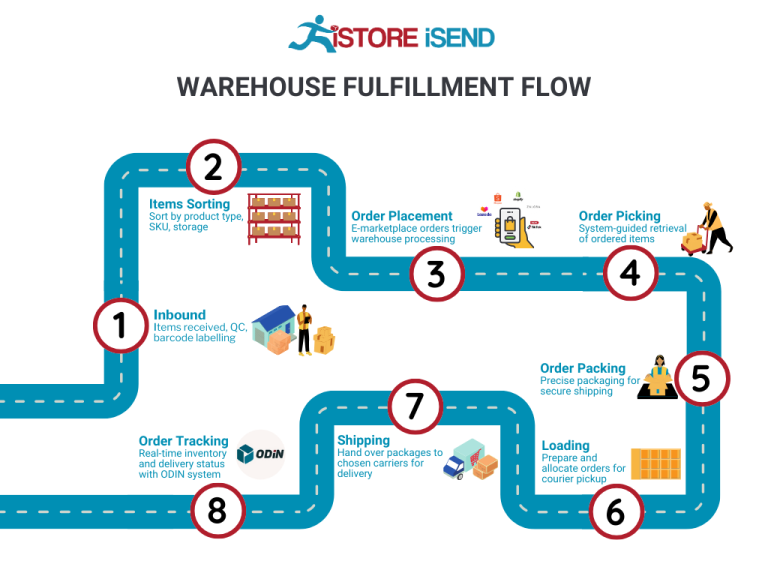
Key Term: Last-Mile Delivery – The final step of the delivery process, where the order is transported from a distribution center to the end customer. This stage is often the most complex and costly, making it a key focus area for optimizing fulfillment operations.
By understanding and optimizing each step of the order fulfillment process, e-commerce businesses can enhance operational efficiency, reduce costs, and ultimately improve customer satisfaction, paving the way for scalable growth.
Comparing Fulfillment Models: In-House vs. 3PL vs. Dropshipping
Comparison of Fulfillment Models
| Model | Who Handles Inventory | Best For (Business Stage) | Key Advantage | Key Disadvantage |
|---|---|---|---|---|
| In-House Fulfillment | Business itself | Established businesses with volume | Full control over inventory and operations | High overhead costs and resource allocation |
| Third-Party Logistics (3PL) | External logistics provider | Growing and scaling businesses | Scalable and flexible service options | Less control over inventory and processes |
| Dropshipping | Supplier | Startups and low-capital businesses | Low startup costs and minimal inventory risk | Lower profit margins and dependency on suppliers |
In-House Fulfillment
In-house fulfillment involves managing the entire inventory and shipping process within your own business. This model is typically best suited for established companies with a steady volume of orders, as it requires significant investment in warehousing, staff, and logistics technology. The primary advantage of in-house fulfillment is the complete control it offers over inventory management, order processing, and customer service. Businesses can implement personalized packing and shipping strategies that enhance customer experience. However, this model comes with significant disadvantages, including high overhead costs and the need for a dedicated workforce. Additionally, scaling operations can be challenging, requiring further investment in infrastructure and staff training.
Third-Party Logistics (3PL)
Third-party logistics (3PL) providers offer businesses the ability to outsource their logistics operations to an external service. This model is particularly advantageous for growing businesses that may not have the resources or capacity to manage fulfillment in-house. 3PLs provide a range of services, including warehousing, order fulfillment, shipping, and even returns management. One of the key benefits of utilizing a 3PL is scalability; businesses can easily adjust their logistics operations based on demand fluctuations without incurring the costs associated with maintaining a large warehouse. However, one of the main drawbacks is the potential loss of control over inventory management and shipping processes, which can lead to inconsistencies in service quality and customer satisfaction if not managed effectively.
Dropshipping
Dropshipping is a fulfillment method where retailers do not hold inventory; instead, they partner with suppliers who fulfill orders on their behalf. This model is ideal for startups and businesses with limited capital, as it requires minimal upfront investment in inventory. The main advantage of dropshipping is the low financial risk, as businesses only pay for products after they have been sold. Additionally, dropshipping allows for a broad product range without the need to manage stock levels. However, there are notable disadvantages, including lower profit margins due to reliance on supplier pricing and potential issues with inventory availability. Moreover, businesses are dependent on suppliers for shipping times and quality control, which can negatively impact customer satisfaction if not closely monitored.
By understanding these fulfillment models, e-commerce business owners and operations managers can make informed decisions that align with their growth strategies and operational capacities. Each model has its unique advantages and challenges, and the choice often depends on the specific needs and stage of the business.
A Deep Dive into Amazon FBA: Pros, Cons, and Who It’s For
Understanding Fulfillment by Amazon (FBA)
Fulfillment by Amazon (FBA) is a service offered by Amazon that allows e-commerce sellers to store their products in Amazon’s fulfillment centers. Amazon then takes care of storage, packaging, shipping, and customer service on behalf of the sellers. This program has revolutionized the way small to medium-sized businesses can operate, giving them access to Amazon’s vast logistics network and customer base.
How FBA Works
-
Sign Up and Product Listing: Sellers first need to create an Amazon Seller account and list their products. They can choose to use FBA for all or some of their listings.
-
Shipping Inventory: Once products are listed, sellers ship their inventory to Amazon’s fulfillment centers. Amazon has numerous warehouses across the country and globally, which helps in efficient distribution.
-
Storage and Fulfillment: Products are stored in Amazon’s warehouses. When a customer places an order, Amazon picks, packs, and ships the product directly to the customer.
-
Customer Service and Returns: Amazon handles customer service inquiries, returns, and refunds for FBA products, allowing sellers to focus on other aspects of their business.
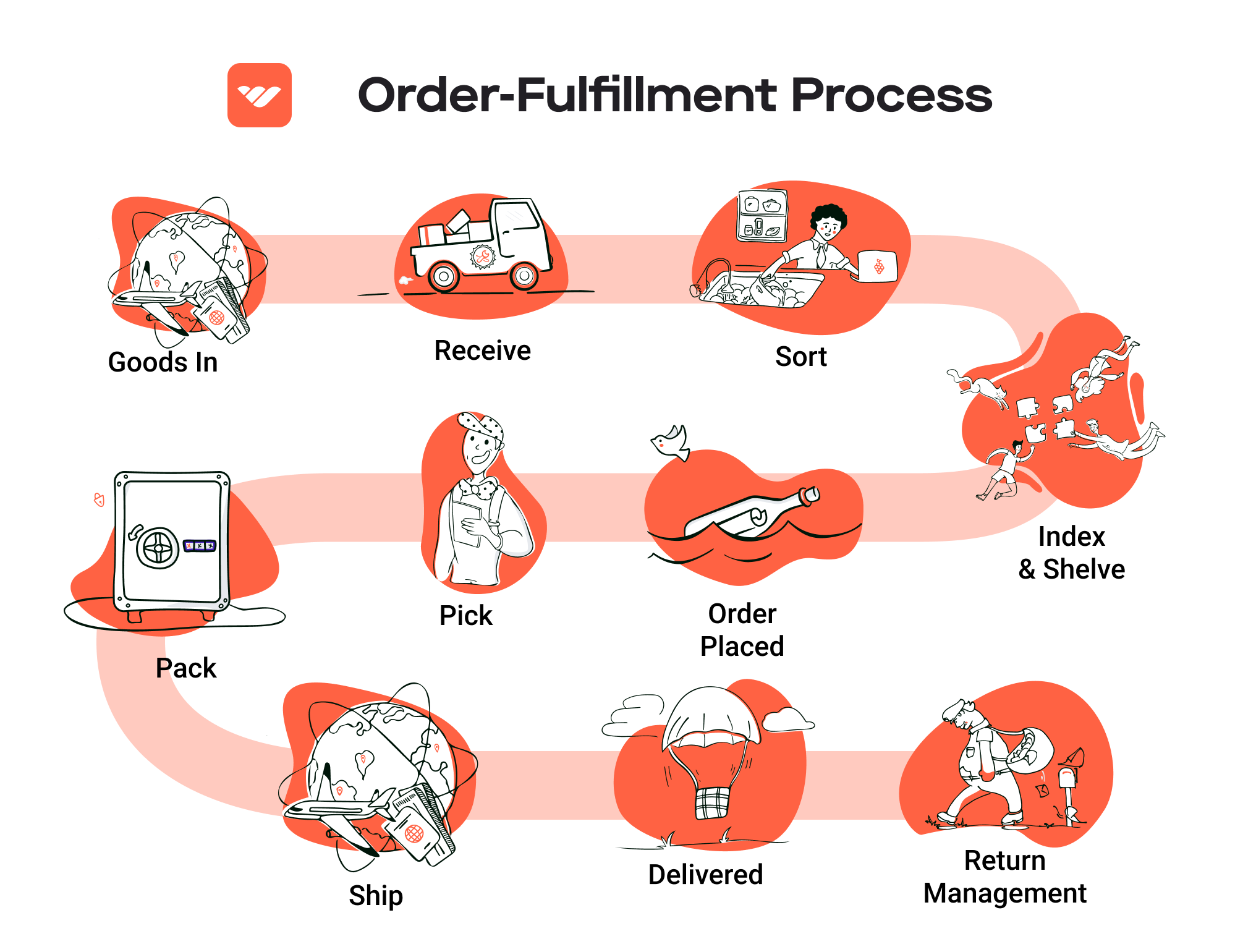
-
Prime Eligibility: Products fulfilled through FBA are automatically eligible for Amazon Prime, enhancing their visibility and attractiveness to customers.
Pros of Using FBA
-
Prime Eligibility: One of the most significant advantages of FBA is that products become eligible for Amazon Prime. This means faster shipping options for Prime members, which can lead to increased sales and customer loyalty.
-
Customer Trust: By leveraging Amazon’s reputation, sellers can gain the trust of potential customers. The Amazon brand is synonymous with reliability, and products fulfilled by Amazon often see a boost in conversion rates due to this trust.
-
Multi-Channel Fulfillment: FBA allows sellers to fulfill orders not just from Amazon but also from other sales channels like their own websites or other marketplaces. This flexibility can streamline operations and improve efficiency.
-
Scalability: FBA is highly scalable, enabling sellers to grow their businesses without the need for significant investment in logistics infrastructure. Sellers can increase their inventory as their business grows, relying on Amazon to manage the fulfillment process.
-
Time Savings: By outsourcing fulfillment, sellers can save time on logistics, allowing them to focus on product development, marketing, and other strategic areas of their business.
Cons of Using FBA
-
High Fees: While FBA can save time, it comes at a cost. Amazon charges various fees, including storage fees and fulfillment fees, which can significantly eat into profit margins. Sellers need to carefully calculate these costs to ensure profitability.
-
Strict Inventory Rules: Amazon has stringent inventory management rules. Sellers must adhere to these rules regarding stock limits, labeling, and packaging, which can be challenging, especially for new sellers.
-
Commingling Risks: FBA may involve commingling inventory, meaning that products from different sellers are stored together. This can lead to issues if a customer receives a product that is not as expected or if there are quality control concerns. It also complicates returns and can affect seller ratings.
-
Dependency on Amazon: Relying on Amazon for fulfillment means that sellers are also dependent on Amazon’s policies and changes. Any alterations to Amazon’s fees or rules can directly impact a seller’s business model.
-
Limited Control Over Fulfillment: When using FBA, sellers have limited control over the fulfillment process. This lack of control can be a concern for businesses that want to maintain a specific customer experience or branding during the delivery process.
Who is FBA Best For?
FBA is particularly well-suited for:
-
Small to Medium-Sized Businesses: Businesses that are looking to scale without investing heavily in logistics can benefit significantly from FBA. It allows them to leverage Amazon’s infrastructure.
-
New Sellers: For entrepreneurs just starting, FBA provides an accessible way to enter the e-commerce market without needing to handle fulfillment logistics themselves.
-
Sellers with High Volume Products: Businesses that sell high volumes of products can take advantage of Amazon’s efficient logistics network, ensuring quick delivery times and better customer satisfaction.
-
Brands Looking to Build Trust: Sellers who want to enhance their brand’s credibility can benefit from the trust associated with Amazon’s fulfillment services.
-
Businesses Focused on Growth: Companies aiming for rapid growth can utilize FBA to scale their operations without the hassle of managing inventory and shipping logistics.
In conclusion, while Fulfillment by Amazon offers numerous advantages that can facilitate growth and streamline operations, it also comes with challenges that need to be carefully weighed. By understanding the pros and cons, e-commerce business owners can make informed decisions about whether FBA aligns with their business goals and operational capabilities.
Core Services Offered by Fulfillment Centers
Inventory Management & Warehousing
Inventory management and warehousing are foundational services provided by fulfillment centers, crucial for e-commerce businesses aiming to streamline operations. This service involves the systematic tracking of inventory levels, orders, sales, and deliveries. Fulfillment centers utilize advanced inventory management systems that integrate with e-commerce platforms, allowing real-time visibility into stock levels and order status.
The benefits of effective inventory management are manifold. Firstly, it reduces the risk of overstocking or stockouts, which can lead to lost sales and customer dissatisfaction. By maintaining optimal inventory levels, businesses can also minimize holding costs associated with excess inventory. Furthermore, efficient warehousing practices ensure that products are stored in a manner that maximizes space utilization and facilitates quick retrieval, thus speeding up the order fulfillment process. This ultimately enhances customer satisfaction through faster delivery times, which is critical in today’s competitive e-commerce landscape.
Pick and Pack Services
Pick and pack services are integral to the fulfillment process, where items are selected from inventory (picked) and then packaged for shipment (packed). This service is particularly vital for e-commerce businesses that often deal with a diverse range of products and order sizes. Fulfillment centers employ trained staff and automated systems to efficiently pick products from shelves, ensuring accuracy and speed.
The primary benefit of pick and pack services is the enhancement of operational efficiency. By outsourcing these tasks, e-commerce businesses can focus on core activities such as marketing and product development while leaving the complexities of order fulfillment to specialists. Additionally, fulfillment centers often have the technology and processes in place to ensure that orders are picked accurately, reducing the likelihood of errors that can lead to returns and customer dissatisfaction. This efficiency not only improves the bottom line by reducing operational costs but also boosts customer loyalty through reliable order fulfillment.
Kitting and Assembly
Kitting and assembly services offered by fulfillment centers involve the grouping of individual items into ready-to-ship sets or the assembly of products that require multiple components. This service is particularly useful for businesses that sell bundles or require product assembly before shipping. For instance, a business selling a gift set may need individual items (like candles, soaps, and lotions) packaged together, or a furniture retailer may need parts assembled before shipping.
The advantage of kitting and assembly lies in its ability to enhance product offerings and improve customer satisfaction. By offering bundled products or pre-assembled items, businesses can create value-added solutions that attract customers and differentiate them from competitors. This service also simplifies the shipping process, as fewer individual items need to be handled, reducing the risk of errors and expediting the fulfillment timeline. Moreover, by streamlining the packing process, businesses can save on shipping costs, as they can optimize the size and weight of packages being sent.
Returns Management (Reverse Logistics)
Returns management, often referred to as reverse logistics, is a crucial service provided by fulfillment centers that focuses on the efficient handling of returned products. In e-commerce, returns are inevitable due to various reasons such as product dissatisfaction, size issues, or shipping errors. A well-managed returns process is essential for maintaining customer trust and satisfaction.
The benefits of effective returns management are significant. Firstly, it allows e-commerce businesses to process returns quickly and efficiently, minimizing the impact on cash flow and inventory levels. Fulfillment centers typically have established procedures for inspecting returned items, restocking them, or processing them for refurbishment or disposal. This not only helps in maintaining accurate inventory records but also ensures that products are available for resale as quickly as possible.
Moreover, a smooth returns process enhances customer experience, as customers appreciate hassle-free returns and exchanges. This can lead to increased customer loyalty and repeat business, which are vital for long-term success. By outsourcing returns management to a fulfillment center, businesses can also gain access to valuable data and insights regarding return trends, enabling them to make informed decisions about product offerings and customer service improvements.
Conclusion
In summary, the core services offered by fulfillment centers, including inventory management and warehousing, pick and pack services, kitting and assembly, and returns management, provide significant advantages to e-commerce businesses. By leveraging these services, businesses can optimize their operations, enhance customer satisfaction, and ultimately drive growth. As the e-commerce landscape continues to evolve, partnering with a proficient fulfillment center can be a strategic move for scaling operations and achieving sustained success.
How to Choose a Fulfillment Partner: A 6-Point Checklist
Location & Warehouse Network
Importance:
The location of your fulfillment partner’s warehouses plays a crucial role in shipping efficiency and costs. Proximity to your customer base can significantly reduce shipping times and expenses, which is vital for maintaining customer satisfaction.
Questions to Ask:
1. Where are your warehouses located?
2. How do these locations align with my target market?
3. What is your average shipping time to my key regions?
4. Do you have a network of warehouses that allows for optimized routing?
5. Are there plans to expand your warehouse locations in the near future?
Technology & Integrations
Importance:
In today’s e-commerce landscape, technology is a key differentiator in fulfillment efficiency. A partner that utilizes advanced technology can streamline operations, provide real-time tracking, and integrate seamlessly with your existing systems.
Questions to Ask:
1. What technology do you use for inventory management and order processing?
2. Can your system integrate with my e-commerce platform (e.g., Shopify, WooCommerce, Amazon)?
3. How do you handle data security and privacy?
4. Do you offer real-time tracking for shipments?
5. What reporting capabilities do you provide to help me monitor performance?
Specializations (e.g., Cold Storage, Oversized Items)
Importance:
Depending on your product type, you may require a fulfillment partner with specific capabilities. For example, if you sell perishable goods, you’ll need a partner with cold storage facilities. Similarly, oversized or bulky items may require specialized handling and storage solutions.
Questions to Ask:
1. Do you have the capability to handle my specific product types (e.g., perishable, oversized, fragile)?
2. What special equipment or processes do you have in place for these items?
3. Can you provide case studies or examples of handling similar products?
4. Are there any limitations on the types of products you can store or ship?
5. How do you ensure compliance with relevant regulations (e.g., food safety, hazardous materials)?
Scalability & Capacity
Importance:
As your business grows, your fulfillment needs will likely evolve. Choosing a partner that can scale alongside your business is essential to avoid disruptions during peak seasons or rapid growth phases.
Questions to Ask:
1. How do you accommodate seasonal spikes in demand?
2. What is your current storage capacity, and how often do you reach it?
3. Can you quickly scale up operations if my sales increase significantly?
4. How do you handle capacity planning and forecasting?
5. What contingency plans do you have in place for unexpected demand surges?
Pricing and Contracts
Importance:
Understanding the pricing structure and contract terms is vital for budgeting and ensuring that you’re getting a fair deal. Hidden fees can quickly erode your profit margins, so transparency is key.
Questions to Ask:
1. What is your pricing structure (e.g., per order, storage fees, shipping costs)?
2. Are there any additional fees I should be aware of (e.g., for returns, special handling)?
3. What is the length of the contract, and are there options for flexibility?
4. Do you offer volume discounts, and how are they structured?
5. What happens if I need to terminate the contract early?
Customer Support & Reviews
Importance:
A reliable fulfillment partner should provide excellent customer support to resolve issues swiftly. Additionally, reviewing feedback from other clients can offer insights into the partner’s reliability and service quality.
Questions to Ask:
1. What customer support options do you offer (e.g., phone, email, chat)?
2. What are your average response times for support inquiries?
3. Can you provide references or case studies from similar businesses?
4. How do you handle issues like shipping errors or damaged goods?
5. What do your existing clients say about your service (e.g., reviews, testimonials)?
Conclusion
Choosing the right fulfillment partner is a critical decision that can significantly impact your e-commerce business’s success. By using this checklist, you can systematically evaluate potential partners to ensure they align with your operational needs and growth objectives. Always remember to conduct thorough due diligence and consider not just the immediate costs, but the long-term value a partner can bring to your business.
Understanding Fulfillment Pricing: A Breakdown of Common Fees
Initial Setup Fees
When partnering with a fulfillment center like Amazon OLM1, the initial setup fee is typically the first charge you encounter. This fee covers the administrative costs associated with onboarding your business into their system. It may include the costs for account creation, system integrations, and initial training on how to use their fulfillment platform.
The setup fee can vary widely based on the complexity of your operations and the fulfillment center’s requirements. For instance, if you have a sophisticated inventory system that needs to be integrated, expect higher fees. Conversely, simpler setups may incur minimal costs. Always clarify what is included in this fee to avoid unexpected charges later.
Receiving Fees
Receiving fees are charged when your inventory arrives at the fulfillment center. This fee typically covers the labor involved in unloading, inspecting, and putting away your products. It can be calculated based on the number of pallets or boxes received or the total weight of the shipment.
For example, if you send a shipment of 10 pallets, the fulfillment center might charge a flat fee per pallet received. This fee can also vary depending on the type of products being received, as fragile or special-handling items may incur higher fees due to the additional care required.
Storage Fees (per pallet/bin)
Storage fees are incurred for the space your inventory occupies in the fulfillment center. These fees are generally calculated on a per-pallet or per-bin basis and are charged monthly.
Typically, storage fees can be tiered based on the total volume of goods stored. For example, the first few pallets may be charged at a higher rate, while additional pallets could be at a lower rate, incentivizing larger inventory volumes. Additionally, some fulfillment centers may implement seasonal adjustments, where storage fees increase during peak periods, such as the holiday season, due to higher demand for storage space.
Pick & Pack Fees (per item/order)
Pick and pack fees are critical for understanding your overall fulfillment costs, as they cover the labor involved in retrieving items from inventory and packaging them for shipment. This fee is usually calculated on a per-item or per-order basis.
For instance, if an order contains five different products, you may incur a fee for picking each item and an additional fee for packing the entire order. Some fulfillment centers offer tiered pricing, where the cost per item decreases as order volume increases. This structure can be beneficial for businesses with high order volumes, as it encourages efficiency and cost savings.
Shipping Fees
Shipping fees represent one of the most variable costs in fulfillment pricing. These fees are calculated based on several factors, including the destination, weight of the package, shipping method (standard, expedited, etc.), and the shipping carrier used.
Fulfillment centers often have negotiated rates with shipping carriers, which can lead to cost savings for your business. It’s essential to understand how these fees are structured, as they can significantly impact your overall fulfillment costs. Some centers may offer flat-rate shipping options for certain products or regions, while others may charge based on dimensional weight.
Tips for Getting an Accurate Quote
To ensure you receive an accurate quote for fulfillment services, consider the following tips:
-
Provide Detailed Product Information: Share specifics about your products, including dimensions, weights, and any special handling requirements. This information helps fulfillment centers accurately estimate storage and shipping fees.
-
Clarify Your Needs: Be clear about your expected order volumes, shipping frequency, and any seasonal fluctuations in demand. This clarity can help fulfillment centers provide tailored pricing.
-
Ask About Hidden Fees: Inquire about any additional fees that may not be immediately apparent, such as returns processing fees or long-term storage fees for inventory that remains unsold.
-
Compare Multiple Quotes: Obtain quotes from several fulfillment centers to compare pricing structures and services. This approach can help you identify the best value for your specific needs.
-
Negotiate Terms: Don’t hesitate to negotiate pricing or terms, especially if you anticipate high volumes. Fulfillment centers may be willing to offer discounts or improved rates for committed long-term partnerships.
By understanding these common fulfillment pricing models and following these tips, you can better manage your logistics costs as you scale your e-commerce business.
Frequently Asked Questions (FAQs) about Fulfillment
1. What is Amazon OLM1 Fulfillment Center?
Amazon OLM1 is a fulfillment center located at 3300 Hogum Bay Rd NE, Lacey, WA 98516. It is part of Amazon’s extensive logistics network, designed to store and process products for efficient distribution to customers across various regions.
2. How does the fulfillment process work at Amazon OLM1?
The fulfillment process at Amazon OLM1 involves receiving products from suppliers, storing them in the warehouse, picking items from inventory when orders are placed, packing them for shipment, and finally, shipping them out to customers. This streamlined process is essential for ensuring timely deliveries.
3. What types of products can be stored at OLM1?
OLM1 can accommodate a wide range of products, including electronics, household goods, clothing, and more. However, items must comply with Amazon’s guidelines regarding safety and storage to ensure they can be processed efficiently.
4. What is the difference between a warehouse and a fulfillment center?
A warehouse primarily focuses on storing goods, while a fulfillment center is designed for processing and shipping orders. Fulfillment centers like OLM1 incorporate additional services such as inventory management, order picking, packing, and shipping, making them essential for e-commerce operations.
5. What is a Third-Party Logistics Provider (3PL)?
A Third-Party Logistics Provider (3PL) is a company that offers outsourced logistics services, including warehousing, transportation, and order fulfillment. Businesses often partner with 3PLs to streamline their supply chain and reduce operational costs.
6. How much do fulfillment services cost?
The cost of fulfillment services varies based on factors such as the volume of orders, the size and weight of products, storage requirements, and the level of service provided. Businesses should evaluate multiple fulfillment providers to find a solution that fits their budget and operational needs.
7. How can I track my orders fulfilled by OLM1?
Amazon provides tracking information for all orders processed through their fulfillment centers, including OLM1. Once an order is shipped, customers can access tracking details through their Amazon account or the confirmation email they receive.
8. What are the benefits of using Amazon OLM1 for fulfillment?
Using Amazon OLM1 for fulfillment offers several benefits, including fast shipping times, access to Amazon’s vast customer base, and the ability to leverage Amazon’s advanced logistics technology. This can significantly enhance customer satisfaction and improve order accuracy.
9. What measures are in place to ensure order accuracy at OLM1?
Amazon employs a combination of advanced technology, including robotics and AI, along with strict operational protocols to ensure order accuracy. Regular audits and quality checks are conducted to minimize errors during the picking and packing processes.
10. Can I integrate my e-commerce store with Amazon OLM1?
Yes, businesses can integrate their e-commerce platforms with Amazon’s fulfillment services. This integration allows for seamless order processing and inventory management, enabling sellers to manage their operations more efficiently while utilizing Amazon’s logistics capabilities.
Conclusion: Is Outsourcing Fulfillment the Right Move for Your Business?
Evaluating the Benefits of Outsourcing Fulfillment
Outsourcing fulfillment can be a transformative decision for e-commerce businesses aiming to scale efficiently. One of the most significant advantages is the time savings it offers. By delegating the logistics of packing, shipping, and handling returns to a specialized partner, you can focus on core business activities such as product development and marketing. This shift not only enhances productivity but also allows for more strategic decision-making.
Scalability is another key benefit. As your sales volume fluctuates, a fulfillment service can adapt to your needs without the need for significant capital investment in infrastructure. This flexibility is crucial in today’s dynamic market, where consumer demand can change rapidly. A reliable fulfillment partner can handle increased order volumes seamlessly, ensuring that customer expectations are consistently met.
Moreover, partnering with a fulfillment service provides access to expertise and technology that may be cost-prohibitive for smaller businesses. From sophisticated inventory management systems to efficient shipping solutions, leveraging these resources can enhance your operational efficiency and customer satisfaction.
However, the choice of a fulfillment partner is critical to your success. Conduct thorough research and due diligence to ensure that the provider aligns with your business goals and can support your growth trajectory. Look for partners with a proven track record, robust technology, and strong customer service capabilities.
Take Action
Now is the time to assess your current shipping and fulfillment processes. Are they hindering your growth potential? Conduct an audit of your logistics operations to identify inefficiencies and determine whether outsourcing fulfillment could be the right strategic move for your business. Embrace the opportunity to streamline your operations and position your brand for success in the competitive e-commerce landscape.
Important Disclaimer
⚠️ Important Disclaimer
The information in this guide is for educational purposes. Fulfillment services, pricing, and platform features change frequently. Always conduct your own due diligence and consult with providers directly before making business decisions.
